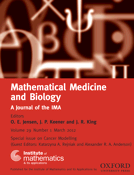-
Views
-
Cite
Cite
H. Hatzikirou, D. Basanta, M. Simon, K. Schaller, A. Deutsch, ‘Go or Grow’: the key to the emergence of invasion in tumour progression?, Mathematical Medicine and Biology: A Journal of the IMA, Volume 29, Issue 1, March 2012, Pages 49–65, https://doi.org/10.1093/imammb/dqq011
Close - Share Icon Share
Abstract
Uncontrolled proliferation and abnormal cell migration are two of the main characteristics of tumour growth. Of ultimate importance is the question what are the mechanisms that trigger the progression from benign neoplasms (uncontrolled/autonomous proliferation) to malignant invasive tumours (high migration). In the following, we challenge the currently prevailing view that the emergence of invasiveness is mainly the consequence of acquired cancer cell mutations. To study this, we mainly focus on the ‘glioblastoma multiforme’ (GBM) tumour which is a particularly aggressive and invasive tumour. In particular, with the help of a simple growth model, we demonstrate that the short time required for the recurrence of a GBM tumour after a gross total resection cannot be deduced solely from a mutation-based theory. We propose that the transition to invasive tumour phenotypes can be explained on the basis of the microscopic ‘Go or Grow’ mechanism (migration/proliferation dichotomy) and the oxygen shortage, i.e. hypoxia, in the environment of a growing tumour. We test this hypothesis with the help of a lattice-gas cellular automaton. Finally, we suggest possible therapies that could help prevent the progression towards malignancy and invasiveness of benign tumours.





